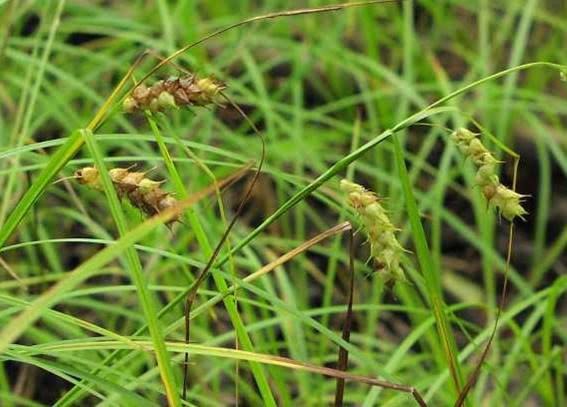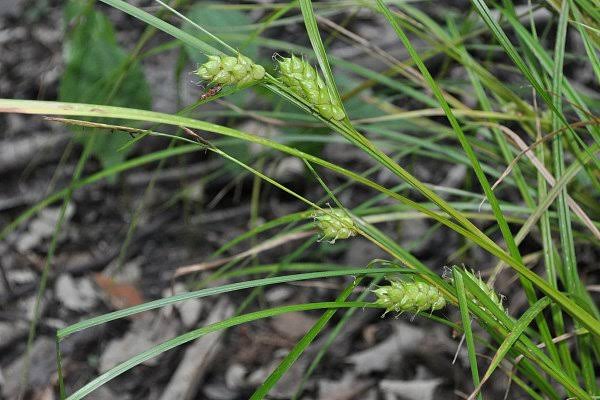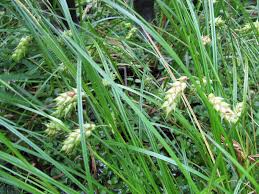Tuckerman’s sedge (Carex tuckermanii) is a type of plant that grows in wet areas, like swamps and wet meadows. This little plant may not catch your eye at first, but it plays an important role in the ecosystem.
Its scientific name, Carex tuckermanii, might sound a bit fancy, but all it means is that this sedge belongs to the Carex genus, and its specific name is tuckermanii. People who study plants use these names to tell them apart.
Now, let’s talk about what makes Tuckerman’s sedge interesting. This plant has long, narrow leaves that are green and grass-like. You might mistake it for ordinary grass, but take a closer look, and you’ll see the subtle differences.
Tuckerman’s sedge is not just here for decoration – it serves a purpose. One of its main jobs is to help prevent soil erosion. The roots of this little plant dig deep into the ground, holding the soil together. It’s like nature’s way of keeping things stable.
But that’s not all – Tuckerman’s sedge also provides a home for other living things. Small insects and critters find shelter among its leaves, creating a mini-habitat. It’s like a tiny apartment complex for nature’s tiniest residents.
If you happen to be near a wetland or a swamp, you might spot Tuckerman’s sedge doing its job quietly. It doesn’t demand attention, but it plays a vital role in the circle of life. So, next time you see a patch of green in a soggy area, take a moment to appreciate the humble Tuckerman’s sedge for all that it does to keep things in balance.
Read Also: Full Sun Flowers: All You Need To Know About
How To Grow Tuckerman’s Sedge (Carex tuckermanii)

Growing Tuckerman’s sedge (Carex tuckermanii) can be a rewarding experience. Here’s a simple guide to help you cultivate this plant in your garden or wetland area.
1. Know Your Zone: Tuckerman’s sedge thrives in wet areas, so if you have a swampy or moist spot in your garden, that’s an ideal location. Check your USDA hardiness zone to ensure it’s suitable for this plant.
2. Soil Preparation: Ensure the soil is well-draining and rich in organic matter. Tuckerman’s sedge prefers slightly acidic to neutral soil conditions. Amending the soil with compost can enhance its fertility.
3. Planting: Spring or early fall is the best time to plant Tuckerman’s sedge. Dig a hole that’s slightly larger than the plant’s root ball and place it in the hole at the same depth as it was in its container. Space multiple plants about a foot apart to allow them room to grow.
4. Watering: Keep the soil consistently moist, especially during the initial establishment period. Regular watering is crucial for the health of Tuckerman’s sedge, as it naturally grows in wet conditions.
5. Sunlight: Tuckerman’s sedge prefers partial to full shade. Ensure it gets enough light without being exposed to harsh, direct sunlight for extended periods.
6. Mulching: Applying a layer of mulch around the base of the plant helps retain moisture, suppress weeds, and maintain a more stable temperature for the roots.
7. Maintenance: Tuckerman’s sedge is a low-maintenance plant. Remove any dead or damaged foliage to keep it looking tidy. If you’re growing it near other plants, be mindful of potential overcrowding.
8. Propagation: Tuckerman’s sedge can be propagated by division. As the plant matures, you can carefully divide the clumps and replant them in suitable locations.
9. Wildlife Attraction: Tuckerman’s sedge attracts various insects and wildlife. Embrace this natural ecosystem by observing and appreciating the biodiversity it brings to your garden.
Remember, patience is key when growing Tuckerman’s sedge. It might not grow as rapidly as some other plants, but its contribution to the local environment makes it a valuable addition to any garden with suitable conditions.
How To Care For Tuckerman’s Sedge (Carex tuckermanii)
Caring for Tuckerman’s sedge (Carex tuckermanii) involves simple steps to ensure its well-being in its preferred wetland or garden environment:
1. Watering: Tuckerman’s sedge naturally grows in wet areas, so maintaining consistently moist soil is crucial. Water the plant regularly, especially during dry periods. Avoid letting the soil dry out completely, but also ensure it doesn’t become waterlogged.
2. Soil Conditions: Ensure the soil is well-draining and rich in organic matter. Tuckerman’s sedge prefers slightly acidic to neutral soil. Mulching around the base helps retain moisture and keeps the soil cool.
3. Sunlight: Tuckerman’s sedge thrives in partial to full shade. While it can tolerate some sunlight, prolonged exposure to harsh, direct sunlight might stress the plant. Aim to provide it with the dappled light conditions it prefers.
4. Pruning: Tuckerman’s sedge is a low-maintenance plant, but removing any dead or damaged foliage can help maintain its appearance and overall health. Prune as needed, especially during the growing season.
5. Fertilization: Generally, Tuckerman’s sedge doesn’t require frequent fertilization. However, if the soil lacks nutrients, you can apply a balanced, slow-release fertilizer in the spring to support its growth.
6. Wildlife Interaction: Embrace the wildlife that Tuckerman’s sedge attracts. Insects and other small creatures may find refuge in its foliage. Allow this natural ecosystem to thrive, as it contributes to the overall biodiversity of your garden.
7. Division: As the plant matures, you may consider dividing clumps to propagate new plants. This can rejuvenate the original plant and provide opportunities to expand the presence of Tuckerman’s sedge in your garden.
8. Monitor Surroundings: Keep an eye on the surroundings of Tuckerman’s sedge. If it’s growing near other plants, make sure there’s no aggressive competition or overcrowding. Adjust the planting arrangement if necessary to maintain a harmonious garden environment.
9. Winter Protection: In colder climates, Tuckerman’s sedge is generally hardy, but adding a layer of mulch around the base can provide some protection during the winter months.
Caring for Tuckerman’s sedge involves understanding and mimicking its natural habitat. By recreating the ideal conditions, you’ll help this plant thrive and contribute to the ecological balance in your garden or wetland area.
Read Also: Significance And Uses of Zantedeschia Aethiopica Flower
The Uses of Tuckerman’s Sedge (Carex tuckermanii)

Tuckerman’s sedge (Carex tuckermanii) may not have a long list of direct uses for human consumption or manufacturing, but it plays essential ecological roles and contributes to the overall health of wetland ecosystems. Here are some notable uses and benefits:
1. Erosion Control: The dense root system of Tuckerman’s sedge helps prevent soil erosion in wetland areas. By stabilizing the soil, it contributes to maintaining the structure and health of these ecosystems.
2. Wildlife Habitat: Tuckerman’s sedge provides a habitat for various insects and small creatures. Insects find shelter among its leaves, contributing to the biodiversity of the surrounding environment. This, in turn, can attract other wildlife that rely on these insects for food.
3. Wetland Restoration: In wetland restoration projects, Tuckerman’s sedge can be strategically planted to enhance the ecological functions of the area. Its ability to thrive in wet conditions makes it a valuable component in such restoration efforts.
4. Biodiversity Support: The presence of Tuckerman’s sedge contributes to the overall biodiversity of wetland ecosystems. It creates microhabitats that support a variety of plant and animal species, fostering a balanced and resilient ecosystem.
5. Aesthetic Value: While not traditionally used for ornamental purposes, Tuckerman’s sedge can add a natural and native aesthetic to wetland gardens. Its grass-like appearance and adaptability to wet conditions make it a valuable component in landscaping projects focused on preserving native flora.
6. Educational Purposes: Tuckerman’s sedge can be used in educational settings to teach about wetland ecosystems, plant adaptations, and the importance of native plants in maintaining ecological balance. Its presence in educational gardens can serve as a living example of these concepts.
7. Carbon Sequestration: Like many plants, Tuckerman’s sedge plays a role in carbon sequestration. Through photosynthesis, it absorbs carbon dioxide from the atmosphere and stores carbon in its biomass, contributing to the mitigation of climate change.
While Tuckerman’s sedge may not have direct uses in human activities, its ecological functions make it a valuable and integral part of wetland ecosystems. Its ability to thrive in specific environmental conditions makes it an essential player in maintaining the health and balance of these natural areas.
Frequently Asked Questions (FAQs)
Q: What is Tuckerman’s sedge (Carex tuckermanii)?
A: Tuckerman’s sedge, scientifically known as Carex tuckermanii, is a plant that typically grows in wetland areas, such as swamps and wet meadows. It is characterized by its long, narrow leaves and plays crucial roles in preventing soil erosion and providing habitat for various wildlife.
Q: Where does Tuckerman’s sedge thrive best?
A: Tuckerman’s sedge thrives in wet areas, particularly in swampy or moist conditions. It prefers locations with consistently moist soil, making it well-suited for wetlands, marshes, and similar environments.
Q: How do I care for Tuckerman’s sedge in my garden?
A: Ensure the soil is well-draining and consistently moist. Plant in partial to full shade, prune dead foliage as needed, and consider applying a balanced, slow-release fertilizer if the soil lacks nutrients. Tuckerman’s sedge generally requires low maintenance.
Q: Can I grow Tuckerman’s sedge in different climates?
A: Tuckerman’s sedge has specific preferences for wet conditions. Check your USDA hardiness zone to ensure it’s suitable for your region. It typically grows well in temperate and cooler climates.
Q: Does Tuckerman’s sedge have any ornamental value?
A: While not traditionally used for ornamental purposes, Tuckerman’s sedge can add a natural aesthetic to wetland gardens. Its grass-like appearance and adaptability to wet conditions make it a valuable component in landscaping projects focused on native flora.
Q: How can Tuckerman’s sedge contribute to the environment?
A: Tuckerman’s sedge contributes to the environment by preventing soil erosion, providing habitat for insects and small creatures, supporting biodiversity in wetland ecosystems, and playing a role in carbon sequestration through photosynthesis.
Q: Can Tuckerman’s sedge be propagated?
A: Yes, Tuckerman’s sedge can be propagated by division. As the plant matures, you can carefully divide the clumps and replant them in suitable locations to rejuvenate the original plant and expand its presence in your garden.
Q: Is Tuckerman’s sedge suitable for wetland restoration projects?
A: Yes, Tuckerman’s sedge is suitable for wetland restoration projects. Its ability to thrive in wet conditions and contribute to soil stability makes it a valuable component in efforts to restore and enhance the ecological functions of wetland areas.
Q: Does Tuckerman’s sedge attract wildlife?
A: Yes, Tuckerman’s sedge attracts various insects and small creatures, creating a habitat that can, in turn, attract other wildlife that rely on these insects for food. It contributes to the overall biodiversity of the surrounding environment.
Read Also: Fried Tilapia Fish – Diet, Recipes, and Health Benefits

